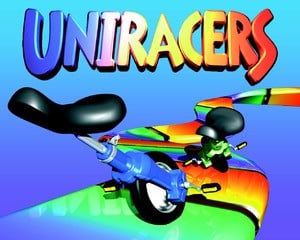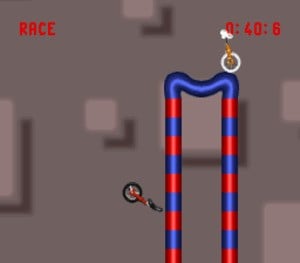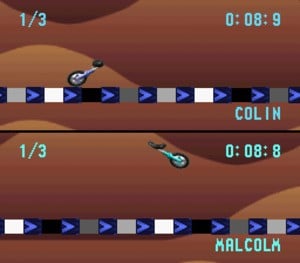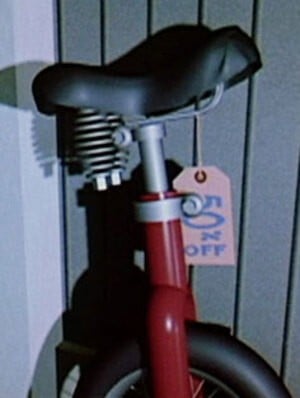
If you consider yourself to be a true artisan then there’s nothing worse that pouring your heart and soul into creating something truly breathtaking only to then be accused of flagrant plagiarism; such an allegation robs you of the unique satisfaction that crafting something truly beautiful brings. Spare a thought then for the development team of Unirally - they succeeded in forging an astoundingly enjoyable piece of software that was robbed of the limelight thanks to largely unfounded claims of idea-theft.
Developed by Scottish code house DMA Design and published for Nintendo’s dominant Super NES console in 1994, Unirally (or Uniracers as it was known outside of Europe) was anything but a conventional video game release. Announced in the CGI-tinged wake of Donkey Kong Country, DMA’s racer was initially viewed with almost equal amounts of suspicion and expectation – the visuals possessed that shiny rendered look that so many developers craved at the time but also retained a degree of simplicity that lead many early sceptics to comment that it was little more than glorified tech demo. Ironically, this was actually closer to the truth than many suspected.
Subscribe to Nintendo Life on YouTube841k

The birth of Unirally, like so many of DMA’s other titles, is typically unorthodox. “Unirally actually evolved from a tech demo,” recollects former DMA Design member Andrew Innes. “It was an obscenely difficult unicycle simulator and it was decided that it could be turned into a game. I think there are parallels between this and Lemmings, which evolved from some Deluxe Paint animations of little walking men, and Grand Theft Auto, which evolved from a tech demo of a software-rendering engine. This style of game genesis differs markedly from every other company I’ve been involved with; the typical approach is to remake whatever is currently selling well, but put more stuff in it and do shinier graphics.”
Fellow DMA Design cohort Robbie Graham expands on this with the not-particularly-astonishing fact that Unirally didn’t actually begin life as a racing game: “The goal was to do a platformer with a unicycle character as this had plenty of potential for interesting physics and balancing gameplay. As the design progressed, it became more and more a racer and less a ‘platform’ type game. As the racing part became more important and the Advanced Computer Modelling on the unicycle ate up much of the graphics memory, the game adopted its unique ‘clean’ look.”
These graphics obviously enabled Unirally to stand out from the crowd and to some degree game capitalized on the frenzy of interest Donkey Kong Country had created in the art of CGI. However, adopting this new technology put additional pressure on the designers. “Although the unicycle in-game was probably no more than about 32 pixels high, the source 3D geometry had every detail present and correct,” recalls Graham. “Even the threads of the screws inside the unicycle frame were modelled.”

Creating the unicycle characters was only one part of the puzzle – it was also vital to ensure that the animation was smooth and packed with character – this also caused headaches. “It’s not a 3D model in the game, but a series of 2D images of the 3D unicycle in all the potential positions” explains Graham. “When you consider that the unicycle can tilt and stretch with speed, the saddle can move, it can flip with various stunts and that for most or those positions there needed to be 16 versions for the different pedal positions (they go round and round as they should), it was a data management challenge to say the least. I remember seeing the unicycle frames all printed out on A0 paper and there were hundreds and hundreds of frames.”
Given the level of realism the team wanted to achieve, they felt it was their duty to at least investigate the inner-workings of the subject matter. “Since it was a unicycle game so we thought the team should learn how to unicycle” chuckles Graham. “However the only ‘safe’ place to practice was the main corridor of the office. After the game was complete, the walls of that corridor were absolutely filthy and dented from all those sweaty near death experiences on the unicycle. I’m not sure anyone mastered it properly. I certainly never came close.”
With such extensive research ensuring that the racing portion of the game was suitably perfected, the team started to tinker with the core concept and added the unique idea of performing stunts. “I think it was a natural evolution of the game” recalls Mike Dailly, another key member of the Unirally team. An early stumbling block was encountered, though. “The obvious stunts are just spinning in the various axes” says Innes. “The others - like ‘head-bounce’ - are the only things we could thing of; to be honest there’s not much else you can do with a unicycle. If you notice, in the game there’s a blank space in the ‘Mega Stunt’ menu, which is where we ran out of ideas. Apparently people were phoning up Nintendo help-lines and refusing to believe there was nothing there.”

Then there was the small matter of the two-player split screen mode – a feature that many exalt as the crowning glory of the game and a facet of Unirally that was actually on the cards fairly early in the development period. “I think it was always heading that way - the team really enjoyed racing each other” remarks Dailly. “Usually if a team play the game in their spare time, then you’re on to a winner”. Graham agrees: “It’s a great two player game and this was helped a lot by the stunt reward system – something that at the time had not really been done to my knowledge. Forcing players to pull aerial flips and rolls to win a race really makes the game.”
Innes concurs: “We definitely pushed the competitive aspect; the scope for single-player storyline was inherently limited by virtue of it being a racing game. I remember we had a high-score table going from pretty much the first point we had the game running. A lot of thought went into the statistics tracking because we knew that American gamers liked that kind of thing.” With so much love and care being poured into Unirally it’s unsurprising that DMA actually struggled to fit the code onto the cartridge, as Innes recalls: “As I recall, there was something like 4 bytes free at the end of it all.”

During development Innes discovered that the DMA team had inadvertently created a rather unique and robust copy protection system, the effects of which are still being felt to this day. “Instead of burning EEPROMs for our test cartridges we used to use a disc copy device called because it was so much faster” he recalls. “On one occasion, we sent one of these images off to Nintendo so they could see our progress, but it didn’t work. After some investigation it turned out we had accidentally stumbled upon a method to determine if the game was running off a proper cartridge, as opposed to some other device. I used this information to implement an anti-piracy measure that was so successful that this is the only game I’ve had real trouble getting to run on an emulator.”
Some other aspects of Unirally’s development were equally unexpected, yet endlessly amusing. “I remember writing the swearword censor for the player names, so people couldn’t put offensive stuff on in-store demo copies” continues Innes. “I sent an email round the team requesting offensive word lists and got a few back I hadn’t heard before. Martin Good - who worked on the animations - was particularly helpful in this regard, submitting some awful words I’ve been trying to forget ever since.”
One of the most memorable aspects of Unirally was undoubtedly the innovative user manual. Penned by DMA’s in-house writer Steve Hammond the booklet was refreshingly irreverent and zany, standing in stark contrast the sanitised instruction manuals of the era. “We were all surprised that Nintendo went for it” Hammond admits. “It wasn't like any of the other manuals out there and I was pleased that this got recognised at the time. I'm not entirely certain where the style came from, though I my own sense of humour was pretty dry and sarcastic. Of course I had to do that whilst conveying useful information too.”

Despite his work being admired by many gamers, Hammond found it easy to keep his feet firmly on the ground. “My total royalty cheques for Unirally amounted to something like seventeen quid. I think I bought pizza. The pioneers of the games industry bought Ferraris and swimming pools on the proceeds of their games. I bought ham and pineapple toppings with extra barbecue sauce on a crispy base.”
The negative perceptions expressed by some when the game was first showcased were soundly put to rest when Unirally eventually arrived at retail; as the team at DMA had hoped, it was rightly recognized as an exhilarating combination of speed and stunt work, pre-dating the delicious trick-based mechanics of Tony Hawks Pro Skater by some margin. Reviews were almost unanimously ecstatic and the long-term success of the title seemed assured.
However, ominous rumblings were emanating from the offices of Pixar Animation Studios, producers of Disney-marketed hits such as Toy Story and The Incredibles. Although back then the company had yet to achieve the worldwide fame they now enjoy, they were still brave enough to take Nintendo on over what they perceived to be wholesale theft of one of their ideas.

The problem centred on the Pixar animated short Red’s Dream – produced in 1987 – which featured a cute little unicycle not entirely dissimilar to the ones seen in Unirally. Pixar accused DMA of copying the idea and promptly sued.
Although the DMA team were obviously aware of the short film, plagiarism is something that Dailly refutes to this day: “We modelled the unicycle exactly, based on a real life unicycle. The problem with Pixar was that they seemed to think that any computer generated unicycle was owned by them. They took footage from Red's Dream and compared it to Unirally and the unicycles were virtually the same; this isn't a big surprise as there’s not a lot of ways you can bring life to a unicycle without looking like the one Pixar did. The judge - being the moron that he was - agreed. While it was a unicycle, and did look similar, I think he should have looked at the game as a whole. If he had, then he would have noticed that the game was a completely different environment, and the ‘character’ of the unicycle just wasn't the same.”
With the court case lost, Nintendo had to terminate production of further Unirally cartridges. “The deal was that Nintendo wouldn't make any more carts so Unirally only sold the 300k initial run” remembers Dailly. What could have been a promising franchise was stopped in its tracks. “I do recall some speculation about a 3D version” comments Innes. “But that was more of a thought experiment as to how it would be implemented, I don’t think there was every any serious consideration. Of course, any thought of a sequel was quashed by the whole Pixar affair.”
Dailly is still clearly bemused by the whole affair even today. “It’s like someone making a game about a pen, and Biro claiming ownership over anything to do with pens. At the end of the day, we modelled a real unicycle and it came out the way it did.” At the time of writing Unirally has sadly not been earmarked for release on the Wii’s Virtual Console download service and seems as if the passage of time has done little to soften Pixar’s resolve to see the game buried forever. This is a crying shame because it’s high time that this neglected game - an unfortunate and undeserving victim of corporate pettiness - was given a new lease of life.
This feature originally appeared in its entirety in Imagine Publishing’s GamesTM magazine and is reproduced here with kind permission.





Comments 32
This game looks cool, I will have to look for it at the local used game shop.
Should I be sad for the game or should I facepalm for the idiocy of Pixar?
This game doesnt just look cool it WAS cool, in fact it was very cool. The gameplay was amazing the graphics were great and I am sad to have ever sold it.
Wait... Pixar once did [a] stupid thing[s]?
I knew Uniracers/Unirally [NA/EU] (SNES, 1994) [which I wish to play someday] was based on Pixar's 1987 short film Red's Dream [which I've watched online]. I looked it up a year or two ago.
I never knew it was accused for "plagiarism".
Despite all this, I can't wait to play the game someday.
I'd love to buy this game on Virtual Console if they could emulate it properly... too bad it doesn't sound like Pixar will let that release happen though.
Frankly, it's a rather assinine decision on Pixar's part if the story is accurate. How would this (excellent) video game hurt their sales or their image? Count me out for future Pixar films.
I still have the cart of this on my SNES, bought it on day one because my Nintendo Magazine said it was simply awesome.
I'm never letting this sucker go!
And yes, the Unirally instruction manual was hilarious
I loved this game on the SNES. Was damn difficult as well! Was curious why no VC appearence... at least I know why now.
Nice feature, I always wondered why Uniracers was MIA on the VC. Glad I still have the cart. I've lost, tossed, traded, and sold most games I owned from that era, and my SNES has disappeared, but if I get another i've got the one game I need.
Amazing game.
great game, but I used to own my friends so I couldn't get them to play for long
When this game came out on SNES there was a lot of hype surrounding it, so I bought it. I don't think its that good, Probably just about worth 800 points at a push if it came out on VC but I won't be getting it if it does.
My dad bought this game sometime around release. I'm not really sure why he did, but then his tastes seem to have been even more weirdly varied than my own. I did put a fair amount of time into Uniracers, but I'm not really a huge fan or anything. In fact, I'm now wondering how valueable the game might be, since it's apparently so rare...
EDIT: Not very, based on current eBay going prices. Oh, well, I guess I'll just keep it, then.
I claim copyright on cupboards, because I made a 3D one once in Blender. I'm sueing Ikea for billions.
I've been interested in Uniracers for years. I should purchase it one of these days.
I think it's very wrong that they lost the court case over this game.
That animation has absolutely nothing to do with the game other than the fact that there is a unicycle in it that animates slightly.
Imagine how many lawsuits there would be if everyone tried to pull that kind of crap.
Uniracers is awesome!
I have it on my SNES, very creative and underrated racing game.
We had a ball with this game back in the day. Release it on VC please!
Uniracers was a amazing game, This game needs to come out to the VC. The stunts you could do and the races was simply amazing,
I remember purchasing this game based off of the ads in Game Informer (May 1995) and from seeing a demo in Toys R Us. I remember this game being one of the final full-packaged games that I purchased before I finally moved on from the 16-bit era of gaming. There were three kinds of levels in the game: race (to the finish), circuits (laps) and the stunts courses where you attempt to get perform the most tricks before time ran out.
There wasn't much variety in the music but the unicycles themselves were not only well animated but had personally. Sometimes the losing unicycle would pound it's "head" repeatedly at the end of a race or hang it's seat in shame. The way that the game taught you how to read the track (meaning if it turns solid yellow, then jump) added a lot to the game, too.
As you can probably tell, I really liked this game. I might even have this in my old SNES box downstairs in the bookcase (the battery must be shot though).
I like Pixar's short films
Red's Dream was a good short film when I saw it years ago. The unicycle was cute; the clown, however, ...
classic game.
Oh my god, I have never heard this story before, thank you for bringing it to our attention.
I also didn't realise DMA made Unirally/racers until now.
It's pretty sickening to read, and if true has lost me massive respect for Pixar.
Nintendo should get revenge for them and crush pixar claiming that WALL-E is a rip-off of R.O.B the robot.
How utterly ridiculous. I never knew this story. I always wondered why this game wasn't hugely popular. Everyone I knew who played it was completely floored. I didn't like Pixar before, but this has sealed the deal.
This game a so much fun, I had totally forgotten about this game till now. What isn't this on VC?
http://www.youtube.com/user/monkeytrapgames?feature=mhw5#p/a/u/0/CGw2HJxJyOM
@JimLad: Walli really does look like R.O.B. But R.O.B. had been around since the eighties, and Walli hasn't. I remember another lawsuit similar to this also during the 90s, when Furbies were all the rave: the producers of Gremlins sued the toymaker because the Furbies bared likeness to the Gremlins (they looked really cute prior to being exposed to water, which turned them into monsters).
But I think Uniracers would never have been an issue if it weren't for the Unicycle being Riderless. Meaning if they'd put dudes on the Uniracers, then Pixar wouldn't have sued. I ordered the game on Amazon Marketplace. I hope it's worthwhile.
"Announced in the CGI-tinged wake of Donkey Kong Country, "
I hate to nitpick (OK that's a lie) but Uniracers was released before Donkey Kong Country. I bought Uniracers back then, t'was a simpler time when I would just mosey over to Toys R Us and browse around the games until I found one that looked interesting. But unfortunately I can't say I recognized it as an awesome game. My recollection is that I played it for a few hours over the course of a few days, never touched it after that, and ended up selling it.
Amazing that, all these years later, the guys at DMA still find it necessary to mischaracterize Pixar's lawsuit and how it went down. Dailly says, "We modelled the unicycle exactly, based on a real life unicycle. The problem with Pixar was that they seemed to think that any computer generated unicycle was owned by them. They took footage from Red's Dream and compared it to Unirally and the unicycles were virtually the same; this isn't a big surprise as there’s not a lot of ways you can bring life to a unicycle without looking like the one Pixar did. The judge - being the moron that he was - agreed. While it was a unicycle, and did look similar, I think he should have looked at the game as a whole. If he had, then he would have noticed that the game was a completely different environment, and the ‘character’ of the unicycle just wasn't the same.”
In fact, you need to go no further than the court records, which are public, to see that virtually none of this is true. No "moron judge" ever decided (or had an opportunity to decide) anything; the copying was apparently so demonstrable and obvious that Nintendo (which is not known for backing down from a fight) capitulated almost immediately after the case was brought, before any judge had an opportunity to look at the evidence, much less make a decision, even a preliminary one.
Pixar's claim was not that they owned the concept of animated unicycles, or even that the unicycles looked the same. The claim was that the animation of the Uniracers cycles (particularly for turns, acceleration, and deceleration) was slavishly copied, frame by frame, from the animation of Red, the unicycle in "Red's Dream." There are, in fact, a multitude of ways that a unicycle could be animated, but DMA chose (as Pixar had) to anthropomorphise their cycles by making the seat analogous to the "head," and, for example, having the seat pivot in anticipation of the cycle's turns, so that it would appear that the cycle was "looking where it was about to be going," and to have the seat/head "crane its neck" forward as the cycle leaned in the direction of travel, in order to give the appearance of "intelligence" to the cycles. The problem wasn't so much that the unicycles were "computer generated," or "looked alike," but rather that DMA appeared to have replicated Pixar's specific animation choices in order to convey the personality of the cycles, rather than coming up with their own expression.
It also doesn't help things that the author of this article didn't look to the source material, saying "Pixar accused DMA of copying the idea and promptly sued." Pixar didn't accuse DMA of copying an idea. Pixar accused DMA of having copied the specific expression embodied in Pixar's animation of Red... and apparently Nintendo (which at the time dwarfed Pixar in size and resources, and could easily have defended itself and DMA if there were any doubts about Pixar's claims) felt it was sufficiently obvious that Pixar was right that Nintendo opted to immediately take the product off the market rather than go before a judge.
It's easy and fun to blame "moron judges" for outcomes you don't like; everyone knows that judges make mistakes, and it's compelling to claim to have been the victim of such a mistake. Here, though, the fact that Nintendo backed down to tiny little Pixar rather than risk putting the evidence in front of a judge, speaks pretty loudly.
Interesting @noclothes
Either way, it would be great to see this game again. I owned it back in the day and absolutely loved it. I'm guessing royalties would have to be paid to Pixar now, though, and that seems very unlikely - let alone the fact that DMA is now rockstar - so its likely lost in time.
So Pixar thought that any computer generated unicycle belong to them as if they had invented the unicycle or the computers themselves? Both Pixar and the judge were idiots.
Show Comments
Leave A Comment
Hold on there, you need to login to post a comment...